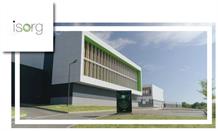Tomorrow's cockpit
ISORG Start-up
Because your security matters.
Isorg is a one-stop provider of security solutions for various market.

A Liten startup, Isorg was founded in 2010 by a team of senior managers and technical experts from the high-tech and electronicsindustries. The company’s core technology successfully integrates printed photodiodes on different substrates to enable large-areaimage sensors for the smartphone, security markets and extended applications in medical X-ray imaging and non-destructive testing(NDT).
Isorg is present in Grenoble, France (technology and application development), Limoges, France (manufacturing), and Asia (sales and application support). The company offers its customers a complete solution from a single provider.
The company plans to leverage its strong know-how of sensor technology to become the leading provider of printed-electronicsbased optoelectronic systems and also complete large-area-imagesensor solutions for the markets the company serves.
Others technologies developped at CEA :
- Printed Electronics
- Additive Manufacturing
- Gas & Particle Sensors
- Haptic Feedback
- Head-up Display (HUD)
ISORG'S SENSOR & MOBILITY
Isorg’s sensor system can be built on a plastic substrate, which means that the product can be shaped to facilitate integration into a variety of products. This makes it ideal for mobility applications that require authentication with a high degree of security. These include smartphones and mobile police scanners, automotive systems, ID verification for electric bike or scooter solutions, and more.
Monitoring
AI VS WILD
Keeping artificial intelligence. Safe from malicious attacks.

Artificial intelligence is gradually making
inroads into many of the technologies people use every day. This spread of AI has broughtwith it new risks. Hackers are now coming up with techniques that take advantage of some of the most vulnerable aspects of deep learning models to alter the system’s decisions. Ultimately, hackers could target systems using AI-based sound or image recognition models, which could negatively impact their security. While it is
still very tough to come up with attacks that are both robust and undetectable, hackers are getting better every day, and it gradually becomes possible to produce attacks using disturbances that are simultaneously difficult to detect for humans and effective in various real world contexts, e.g. variations of the scene luminosity or sound reverberation in the environment.
CEA researchers explored the latest theories on how neural networks function to come up with security technologies capable of protecting AI against these emerging threats. Our demonstrator uses vision and speech recognition systems to show just how powerful attacks on neural networks can be—and just how effective our technology is at protecting systems against these attacks.
AI is a major driver of transformation in transportation and
mobility. Yet, for AI to be widely adopted, autonomous
vehicles must be able to guarantee robust operations even
when under attacks. Besides AI applies to much more than just
driving—AI must be able to offer a sufficient degree of security
in all of the areas in which it will affect mobility. These include
embedded transportation services, personal safety, smart city
solutions, and any other services likely to use customer data.
DEEP RED
Advanced reasoning changes. The software trust landscape.
 For over ten years, CEA teams have been developing and implementing advanced reasoning methods to perform software analysis. Born to keep up with the demanding requirements of safety-critical control systems, these technologies carry out complex verifications over both source and binary codes.
For over ten years, CEA teams have been developing and implementing advanced reasoning methods to perform software analysis. Born to keep up with the demanding requirements of safety-critical control systems, these technologies carry out complex verifications over both source and binary codes.
Our approach was initially focused on providing strong guarantees towards the resilience of critical software components against cyber-attacks, while automating a large part of the tedious tasks of cybersecurity audits.
Our technologies are now sufficiently mature to consider moving beyond critical embedded systems, towards large-scale digital systems with extended applications covering the entire supply chain.
Such tools provide unprecedented assistance to software developers and integrators across all industries, enabling them to consistently deliver high-assurance bulletproof systems.
Software performs a large amount of functions in modern mobility systems:
from communications to entertainment, to drive-by-wire and autonomous
decision-making. DeepRed shows how these complex digital environments and
their supply chains are difficult to secure without extremely powerful reasoning capabilities, backing the industry’s cybersecurity experts.
Others technologies developped by CEA :
- Driver and Passengers onitoring (health, behavior, emotions)
- LIDAR
- IR Imaging
- Sensor Fusion
- AI for Scene Recognition
- Cybersecurity
MAXENS
Maximizing Haptic Sensations
 Haptic refers to the modality of touch as well as to complementarysensory feedback. Haptic interfaces allow human operators to sense and manipulate computer-generated or tele-operated environments through mechanical actuators, ideally with maximum transparency.
Haptic refers to the modality of touch as well as to complementarysensory feedback. Haptic interfaces allow human operators to sense and manipulate computer-generated or tele-operated environments through mechanical actuators, ideally with maximum transparency.
Active or passive haptic devices, depending on the nature of the actuators (motors or brakes), generate different haptic stimuli according to application’s needs (forces and velocities, force dissipation, stability and safety).
MAXENS has been designed as a two-degree-of-freedom hybrid interface using magnetorheological fluid (MRF) brakes and motors. Subjected to a magnetic field, the fluid greatly increases its apparent viscosity, becoming a viscoelastic solid. Importantly, the yield stress of the fluid in its active state can be controlled very accurately by varying the magnetic field intensity. The fluid’s ability to transmit force gives rise to many possible control-based applications.
MRF-based haptic systems offers unique performance in terms of high transparency (low friction), high blocking force (virtual wall effect), high reactivity and dynamics (real-time applications), robustness (compatibility with temperature and vibration environment), all this in compact designs.
MAXENS is a newgeneration multifunctional haptic controller that can be used as a driver/operator assistance system in a variety of vehicles, e.g.:
• trains,
• trams,
• boats,
• airplanes,
• helicopters,
• tractors.
It can also be used in control rooms for monitoring future urban air mobility.
Connectivity
ANTENEO Start-up
New antenna designs. For precision GNSS everywhere.
 Anteneo is bringing precision GNSS to the mass market. We customize our antenna designs to meet specific requirements (radiation pattern, frequency, antenna placement), and then license these turnkey designs out to manufacturers. Our designs are backed by product integration support services.
Anteneo is bringing precision GNSS to the mass market. We customize our antenna designs to meet specific requirements (radiation pattern, frequency, antenna placement), and then license these turnkey designs out to manufacturers. Our designs are backed by product integration support services.
Multi-frequency GNSS is a stand-alone precision geolocation solution, making
it an effective response to mobility-related needs, from ADAS and asset tracking, to free-floating shared vehicles and driverless cars. Anteneo takes the headaches out of antenna integration, one of the major hurdles to the widespread adoption of highprecision GNSS.
Others technologies developped by CEA :
- Wifi Antennas
- 5G
- V2X Communication
- Heterogeneous network management
- Intrusion detection
- Software-defi ned network (SDN)
LIFI-MULTICELL
The world's first smart orchestrator for interference-free lifi networks
 LiFi is a great alternative to WiFi. But there is still a technical challenge to address before being massively deployed: interference management between light sources.
LiFi is a great alternative to WiFi. But there is still a technical challenge to address before being massively deployed: interference management between light sources.
At CES 2020, CEA-Leti will showcase the first-ever multi-cell solution with centralized management of interference between lighting zones.
This solution offers a number of advantages that promise to give
LiFi the boost it deserves:
• The ability to cover large infrastructures
• Uninterrupted connectivity on the move
• High data-transmission rates: 150 Mb/s over distances up
to 3 meters by LED
• Fair allocation of resources between interferred and noninterferred
users
LIFI-MULTICELL & MOBILITY
LiFi-multicell is the first- ever smart interference orchestrator. It can enhance existing solutions by supporting users mobility within a network of light sources
to ensure optimal data rates among users.